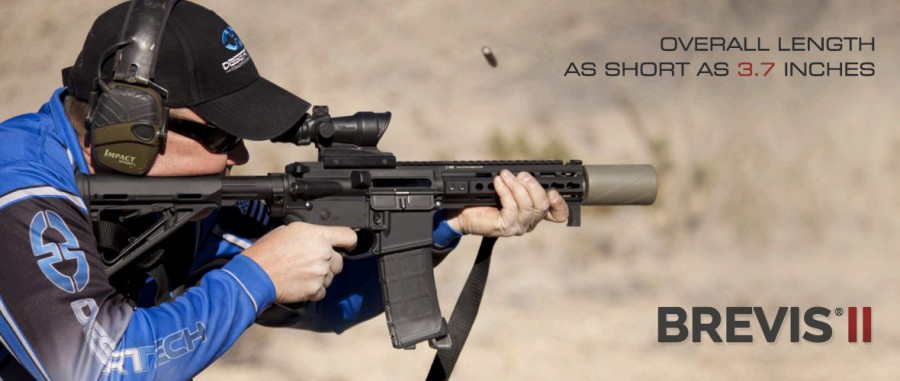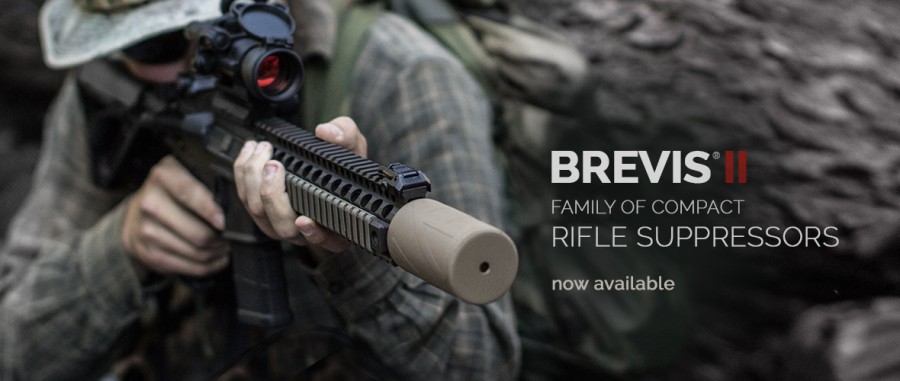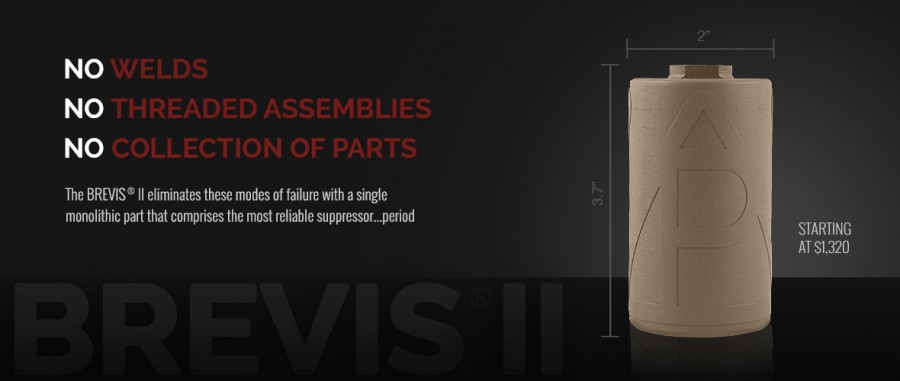I found Delta P Design in, unfortunately, a non-shooting booth at SHOT Show 2015’s range day. They were showing off their BREVIS II line of suppressors, which are made entirely out of a single, monolithic piece of Inconel or titanium. No welds inside or out, no seams, no separate mounting parts. They are uniquely short and very lightweight, and available for 5.56 on up to .338 Lapua Magnum. While they are not serviceable, they are supposed to last the life of a typical barrel and the suggestion is to pretty much permanently mount them as you would any other muzzle device. I’d definitely like to use one on a. . .
.300 Blackout build. Permanently attach it to the barrel so the total length just hits 16″, and run it up against a handguard that matches its diameter. Considering the BREVIS II 7.62 is probably overkill in internal volume for .300 BLK — especially for subsonics — I might suggest to Delta P that they do their tiny 5.56 can bored out for the .30 caliber projectile and market it just for .300 BLK. Anyway, just spitballing here. While I’m making random suggestions, I may as well make a wild speculation about how these are made.
My guess is that they’re cast. Just a guess. Yes, you can cast titanium in a vacuum furnace.
Obviously there’s a downside in that these silencers effectively have a planned obsolescence since they cannot be serviced. Not always a big deal, but in an expensive product that also requires a $200 tax and a waiting period, it’s definitely going to be a barrier to ownership for a lot of folks. If “life of the barrel” is true then, sure, I could probably own that theoretical .300 BLK one for a decade and not wear it out. But I’d like to find out more about any degradation in sound suppression capability as the suppressor fills with carbon and lead over time.
With our man Joe Grine within two hours of Delta P HQ, we’re hoping a shooting range excursion is in their future.







Would you be able to drop this in an ultrasonic cleaner for awhile to get some of the crap out of it? Would it fit in an ultrasonic cleaner?
It would fit in my fairly small ultrasonic cleaner for sure. And, yeah, if I owned one I’d almost certainly attempt to clean it that way every now and then. The difficult part would just be getting all the crud knocked free out the entry or exit hole in the can. I guess you’d run it for a while and then try to flush it out with water or something. Also, Cerakote and other things like that don’t hold up to extended ultrasonic cleaning…
I clean my SOCOM cans in an ultrasonic with MPro7. It’s what Surefire recommends. You just blow the can out with compressed air when it’s done (all this crazy blue smokey stuff comes out) and it’s clean. Yes, the ultrasonic tears up the Cerakote finish. No, I don’t care.
They also said if you don’t have an ultrasonic, just put it in a ziplock bag for 24 hours. That’s how I clean my Ti-rant and it works great.
“Would it fit in an ultrasonic cleaner?”
I’ve used ultrasonics with a tank about the size (the outside size) of a good sized microwave oven, they likely make them a lot larger.
The gunsmith I used to use had one the size of a coffin.
Heh.
When I saw the size of the ultrasonic in that lab, graveyard shift became gun cleaning shift.
A note on high-powered ultrasonic baths: I had tossed my Ruger MK 1 in the tank one night and discovered when I took it out it had a ‘blotchy’ look to the Parkerize finish that I had paid good money for about a year earlier. It had removed about 75 percent of the oxide in places.
I suspected the gunsmith may have not done a thorough job on surface prep.
The strong ultrasonics were also able to heat the water up to about 150 degrees F. after about an hour.
I have to wonder if these might also be made via a 3d printer via laser metal sintering. You probably couldn’t do that with titanium, at least without an inert gas blanket, though it is fun to think about…
http://titanium3dprinting.com/
If I’m not mistaken the Koenigsegg One :1 has 3D printed turbos and exhaust port. It would not be out of the question to print a high pressure gun muffler if a turbo can hold up.
At SHOT Show, I swung by the LionSteel knives booth and saw their new knife with sintered titanium handle: https://www.lionsteel.it/n/en/product/1704/progetto_tidust and got some video of the ones I thought were particularly cool:
So, yeah, it’s definitely possible. I think if they’re making any sort of volume though, casting these would be less expensive and faster to produce. It might also be stronger, but that’s based on nothing more than gut feeling and random assumption. I don’t know how sintered Ti compares to cast Ti, nor do I know if sintered Inconel is possible.
You can do more complex shapes with sintered Ti than casting, Rolls-Royce uses that on turbine blades that have internal cooling passages…
Sintered Inconel is very much possible, I forget who it was, but there was a company that announced a sintered inconel muzzle device a while back.
I think that was Sintercore
http://sintercore.com/brake/
If these came to market at ‘discount’ prices for suppressors, maybe it could make sense. Somehow I doubt their manufacturing costs are anywhere close to cheap, so idk.
Uh, yeah. $1420 for the 5.56 @ 7.5 oz or $100 less with an additional 5 oz., these are definitely not on the “discount” side of the list. Alternatively, you could add 3 oz. & 4 inches and drop the price $700 and get a Mystic X from Liberty.
So are these just a hollow cavity or is there a baffle stack in there? I find it hard to believe there’s no additional construction even with the advent of 3D printing with metal (which can be done with just about anything — even magnesium and titanium).
I have serious doubts that one could print a can and be profitable at $1300 per.
Depends on the design of the printer an exact time required between layers- it may be fast enough to print multiple cans one layer at a time. It’s plausible that an array of laser heads on a frame would work for doing large numbers.
I’ve not seen anyone marketing a multiple-copy 3d printer, but I see no reason it can’t be done.
“I have serious doubts that one could print a can and be profitable at $1300 per.”
There’s another way: 3-D print the wax, then Investment cast the wax. And wax prints fast.
Metal-heads – Is vacuum furnace the only way to cast Ti?
Can it be done under, say, an Argon blanket?
Wait, now. To my knowledge, my SDN-6 is not serviceable, I was told not to bother, if I insisted fill it full of one of the foaming products every few years. And that carbon buildup would increase the suppression. Does anybody really know? Or is this one rumor followed by another? We are roughly 75-80 years of research behind, due to NFA 1934, I don’t think anybody has a REAL answer, just supposition.
A little carbon buildup could help with suppression. A coating on the baffles might help them absorb heat more quickly (black + increase in surface area due to roughness) and it could slightly close the bore diameter of the baffles if it built up in the right places. But… the more interior volume a suppressor has, the more effective it typically is. More room for the gasses to expand and cool down. Just like a larger muffler on a car, all other things being equal, is going to be quieter than a smaller one. So… as the carbon and leading builds up more and more it will reduce the interior volume of the can and it will start to get louder and louder at some point. It takes a lot longer to happen in a nice rifle round like 5.56 that burns relatively cleanly and doesn’t deposit much lead — especially with bullets that are jacketed all the way around the bottom (which is most of them). .22 LR cans are notorious for filling up with unburned carbon, getting thick with leading, etc, and they decrease in effectiveness relatively quickly. Especially since it’s easy to shoot a whole lot of .22 (or at least used to be). This is why basically all new .22 LR cans on the market in the past however many years are user serviceable. Nobody wants a sealed .22 LR silencer!!!
I love the size and the weight of the II Ultra… my question is what’s the muzzle flash and suppression performance like?
Fine, the hardware unit is guaranteed for the life of the barrel…how about the performance?
Would love to see a DB reduction versus shots fired plot.
If I were to invest in any silencer that isn’t user-serviceable, I’d absolutely want to see a plot like that also.
Think I’ll stick to rolling my own…
You make your own suppressors?
Kansas Second Amendment Protection Act.
I will be too, as soon as my first form 1 gets approved and I figure out how to use a lathe. Damn thing just sits there, mocking me for not taking shop class in high school.
I have one of these coming in about a month. I am putting it on my shorty 330blk as an home defense gun. The shorter length is definitely beneficial. Will never come close to shooting that barrel out so the suppressor should last a lifetime–mine.
I will talk to the company and get some more info on some of the issues mentioned here
Lots of military uses. Small and light weight.
Surefire’s got that pretty locked down with the micro line.
Yes, but I don’t think their micro line offers full sound suppression
Sometimes thats enough. The next generation of machine gun barrels for the military is supposed to have integrated suppressors. Since MGs don’t use subsonic ammo the military has settled on an acceptable level of suppression.
If you’re not ruining the hearing of the operator and his nearby buddies that’s plenty good enough for practical battle suppression.
Wow it looks like one of them ‘thar movie silencers!
Been reading up on silencers/suppressors lately, a lot of guys use vinegar or vinegar/hydrogen peroxide mixed to disolve lead fouling. The problem is that it leaves lead acetate, which can easily get into your system and poison you if you don’t dispose of it carefully.
Inconel lasts forever and is insanely expensive.
The material is expensive, but the real fun comes in the machining. Like Monel, sometimes there is no substitute.
I was at SHOT this year and spent some time talking to an owner of a small but well known silencer company. He said his greatest fear was “someone like Ruger coming out with a single piece investment cast silencer, selling it for $89 and putting us all out of business”.
Well, as long as Brevis tries to sell their investment cast silencer for as much as a silencer that can be rebuilt, then maybe the whole investment casting thing isn’t going to succeed.
Don
His greatest fear, my greatest hope. Because you know SIG and the rest won’t sit idly by and let Ruger have the market to themselves. The small independents would probably get bought up outright by the big names to get the rights to their IP so they can get a jump on the competition to get a product to market.
Well there’s still the matter of the $200 tax and the wait time to get that tax stamp back. Even a free silencer costs $200 and a few months before you get to play with it. That sort of insulates the price undercutting thing. I’d consider buying an $89 can that only lasts a couple thousand rounds, but not in a world where it means a $200 tax every few thousand rounds, too. I’d much rather spend $500++ and get a suppressor that comes apart and is supposed to last tens of thousands of rounds and deal with the tax and the wait period just once…
Is there any reason why you couldn’t permanently mount the can on a threaded adapter?